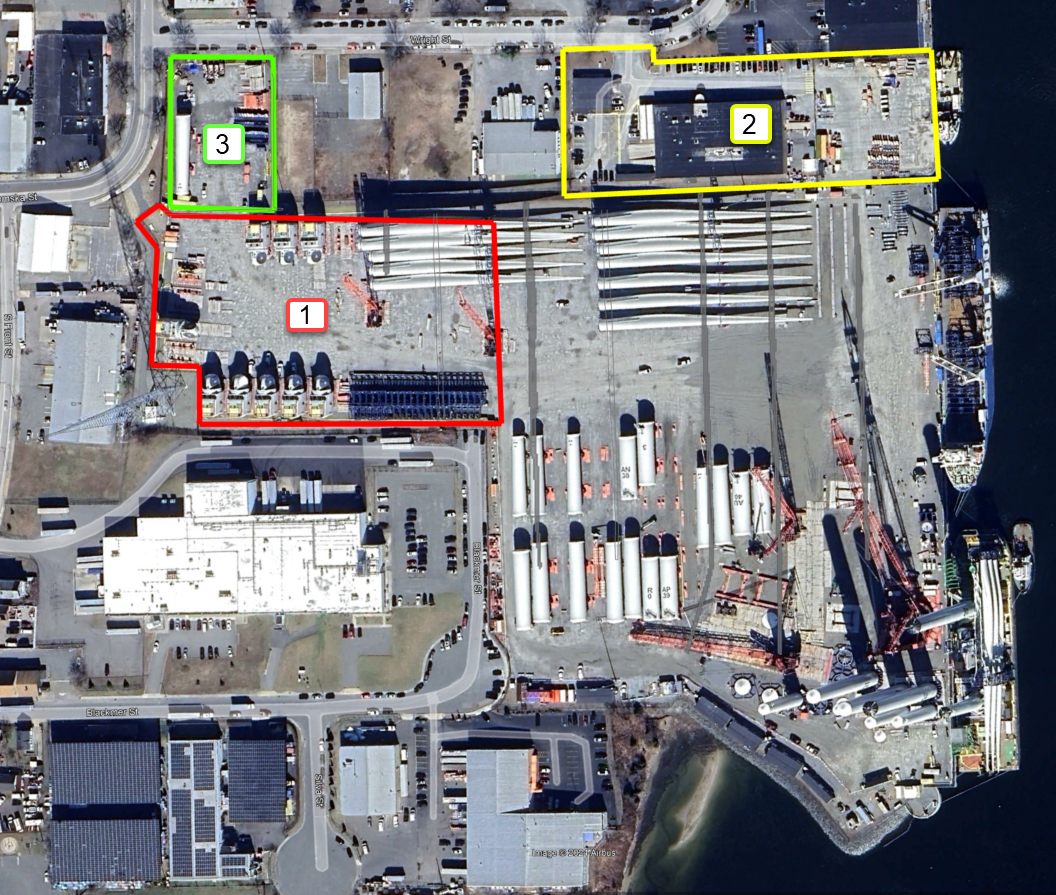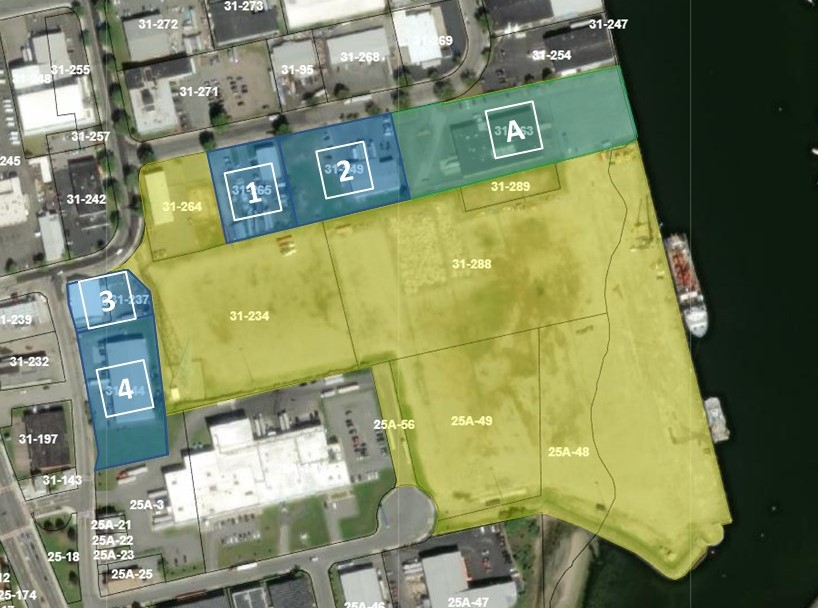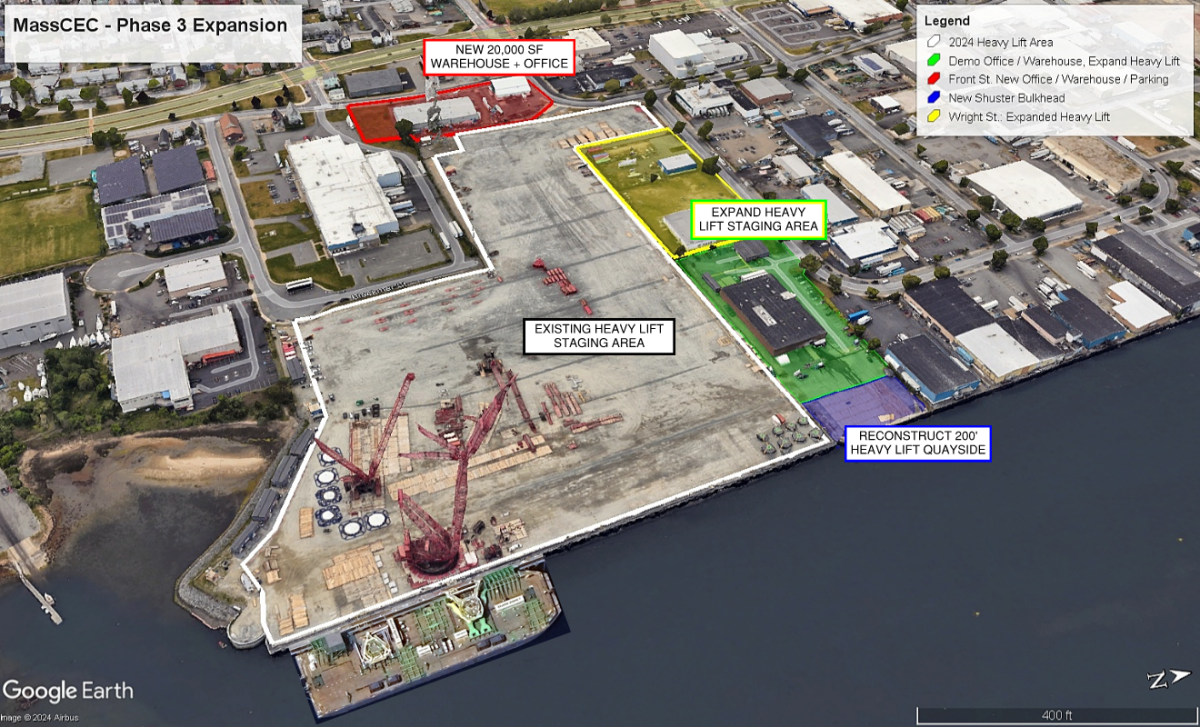Overview
On August 14, 2024, the Massachusetts Clean Energy Center announced plans for the expansion and improvement of the New Bedford Marine Commerce Terminal, a 30-acre purpose-built facility constructed and operated by MassCEC for the construction, assembly, and deployment of offshore wind projects. Currently operating as the staging and pre-assembly port for Vineyard Wind 1, one of the nation’s first commercial scale offshore wind projects, the Terminal is an essential piece of infrastructure for Massachusetts climate goals. The expansion and improvement project represents the commitment of the Commonwealth to ensure that the facility will continue to provide critical support for the deployment of gigawatts of renewable offshore wind and serve as an essential port asset for the emerging U.S. offshore wind industry for years to come.
The overall scope of the project includes: the acquisition of four abutting properties by MassCEC, the replacement of an existing legacy bulkhead with a new high bearing capacity quayside, development of additional heavy lift storage area, and the construction of a new office and warehouse building. When completed, the project will expand the available heavy-lift storage area by 5 acres to a total of 26 contiguous acres (24% increase), increase the total heavy-lift quayside available at the terminal by 200 linear feet to 1,200 linear feet (20% increase), and provide additional office and warehouse space and functionality for Terminal tenants. The project is being advanced in four phases: (1) building demolition/abatement and soil remediation; (2) civil site improvements for high-bearing capacity groundworks; (3) Terminal bulkhead redevelopment; and (4) new office/warehouse construction. The anticipated completion date for the expansion project is December 2026.
Background
With the goal of ensuring the Terminal remains a competitive asset to the developing offshore wind industry, over the past two years MassCEC engaged in a comprehensive strategic planning process that:
- Examined the offshore wind market, current status and trends;
- Conducted an inventory and adequacy assessment for offshore wind ports on the East Coast;
- Evaluated the competitive position of the Terminal against other regional ports for core offshore market scenarios; and
- Identified opportunities for improvement and optimization.
The work was supported by a global team of consultants with extensive offshore wind experience and capabilities, as well as ongoing engagement and consultation with key industry actors, including developers, turbine manufacturers, and installation and transportation businesses. Some of the key findings and recommendations from the strategic planning process were:
- The offshore wind market in the U.S. is on the verge of significant growth, led by state energy commitments of more than 55 gigawatts planned by 2040, and federal leadership from the Biden Administration that has established the Nation’s first offshore wind goal of 30 GW by 2030, along with a national leasing strategy for wind energy area identification and competitive leasing auctions for seven new regions in the Atlantic, Pacific, and Gulf of Mexico.
- Early investments by the Commonwealth have positioned the Terminal as the first purpose-built offshore wind port in the U.S. and currently one of two available marshalling port facilities. There are several other offshore wind marshalling ports in development on the East Coast, and analysis by the US Department of Energy’s National Renewable Energy Laboratory has indicated that the existing and planned port infrastructure is inadequate to meet state and federal goals. Projections show demand for at least 8 marshalling ports by 2026.
- With the increasing size of both turbine components utilized by developer and the projects being procured by states, the available area for component storage and turbine pre-assembly is a constraining factor for the Terminal. Additionally, a portion of the Terminal’s existing bulkhead/quayside area is not optimized, as one parcel acquired after initial construction (referred to as the Shuster parcel) is severely limited in its bearing capacity.
- The expansion of the facility with additional laydown and storage area would increase its handling capacity and throughput, reduce project risks, and could potentially present new opportunities for utilization.
Prior expansion projects for the Terminal have included:
- In 2017, MassCEC acquired the “Hall Communications Radio Tower parcel” (4.2 acres, Site 1 on Figure 1) and the “Shuster Corporation Distribution Center” parcel (2.4 acres and 25,000 sf office/warehouse building, Site 2 on Figure 1). Civil works were conducted at the Hall Communications Radio Tower site to convert the majority of the parcel into high-bearing capacity storage area for the main Terminal.
- In 2022, MassCEC acquired the 80 Wright Street parcel (1.1 acres, Site 3 on Figure 1). Civil works were conducted at this site to convert the majority of the parcel into high-bearing capacity storage area for the main Terminal.

Expansion and Improvement Project
MassCEC’s primary goals for the expansion and improvement of the New Bedford Marine Commerce Terminal are to ensure that the facility will continue to serve as an essential piece of infrastructure for Massachusetts climate goals and provide critical support for the deployment of renewable offshore wind for years to come. The core elements of the project are:
- Acquisition by MassCEC of four abutting properties (Parcels 1-4 on Figure 2);
- Expansion of the Terminal’s available heavy-lift storage area;
- Redevelopment of the existing legacy bulkhead at the Terminal to enable handling of wind turbine generator components across the entire quayside of the facility; and
- Relocation and construction of a new office and warehouse building for tenant and MassCEC personnel and operations.

MassCEC has committed $45 million in funding for the project as part of $180 million investment in a portfolio of seven offshore wind port redevelopment projects in New Bedford, Salem, and Somerset authorized by its Board of Directors in December 2022. When completed the project will expand the available heavy-lift storage area by 5 acres to a total of 26 contiguous acres (24% increase in area) and improve site geometry and component handling logistics, increase the total heavy-lift quayside available at the Terminal to 1,200 linear feet, and provide additional office and warehouse space and functionality for terminal tenants (developers, turbine component suppliers, and other contractors) and MassCEC staff.
In acquisition of the four abutting properties, MassCEC used sales-comparable and income-based approaches that took into account replacement cost values for existing fish processing businesses and negotiated mutually agreeable terms with the sellers to accommodate their plans for business relocation or consolidation.
The project is being advanced in four phases, as depicted in Figure 3 and described below in more detail]: (1) building demolition/abatement and soil remediation; (2) civil site improvements for high-bearing capacity groundworks; (3) Terminal bulkhead redevelopment; and (4) new office/warehouse construction.

Building demolition/abatement and soil remediation
- Abatement of four existing buildings and the responsible disposal of legacy building materials.
- Demolition of four existing buildings to prepare recently acquired properties for development as additional heavy-lift storage area or new office and warehouse site.
- Removal and tie-back of existing utility lines to prepare for the placement of new utility corridors.
Civil site improvements for high-bearing capacity groundworks
- Identification, classification, and disposal of legacy impacted soils as required across high-bearing capacity development properties.
- Removal of geotechnically unsuitable soil materials in order to achieve design high-bearing capacity surface conditions.
- Placement of not less than 3’ of suitable dense graded aggregate in newly constructed heavy-lift areas to serve as both a site pavement surface and environmental cap.
Terminal bulkhead redevelopment
- Construction of a socketed sheet-pile bulkhead inland of legacy cellular cofferdam structures.
- Responsible disposal of existing cofferdam fill materials and demolition of legacy cellular cofferdam structures. Construction of a pile-supported quayside structure to an intended design capacity of 4,100 psf (uniform) in line with the existing main Terminal quayside.
New office/warehouse construction
- Identification, classification, and disposal of legacy impacted soils as required across office and warehouse development properties.
- Construction of a new office and warehouse to support MassCEC and Terminal customer operations with consideration to local traffic flows and site access routing. Increase the number of available off-street parking spaces to support Terminal operations as far as possible and strive to exceed parking requirements as outlined in City of New Bedford zoning requirements.
MassCEC is being supported on the project by Colliers (real estate), Foth (engineering), and Civil & Environmental Consultants (geotechnical and remediation), and Utile (architects). The project team is currently advancing site design concepts, filing for required permits, and procuring contractors for the work scopes.
The anticipated completion date for the expansion project is December 2026. This web page will be updated as the project progresses.
For more information, please contact:
- Tim Griffin, Terminal Director, MassCEC New Bedford Marine Commerce Terminal, tgriffin@masscec.com
- Doug Ernst, P.E. and Project Director, Foth, Doug.Ernst@Foth.com